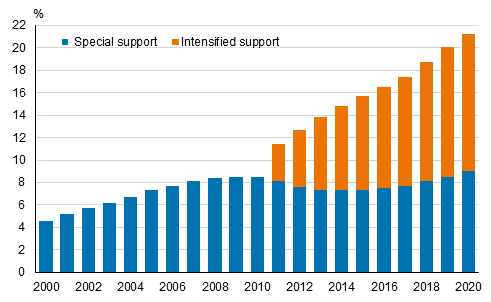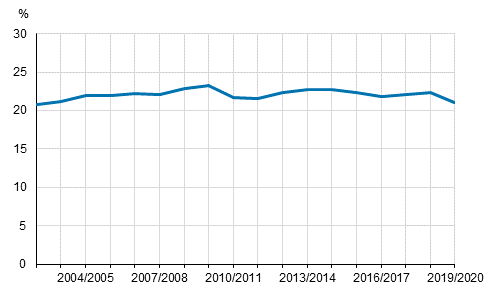Published: 8 June 2021
Intensified or special support for every fifth comprehensive school pupil
Intensified or special support was received by 21.3 per cent of comprehensive school pupils in autumn 2020. Intensified support was received by 69,300, or 12.2 per cent of comprehensive school pupils and special support by 51,100, or 9.0 per cent of comprehensive school pupils. The share of pupils receiving intensified support was 0.7 percentage points higher and that of pupils receiving special support 0.5 percentage points higher than in the previous year. These data derive from Statistics Finland’s education statistics.
Share of comprehensive school pupils having received intensified or special support among all comprehensive school pupils 2000–2020, % 1)

1) Pupils accepted or transferred to special education before 2011 have been regarded as equal to pupils having received special support.
In autumn 2020, a total of 566,600 comprehensive school pupils were in pre-primary, basic and post-basic education of the comprehensive school, 51 per cent of whom were boys and 49 per cent girls.
The three levels of the support system for learning and schooling are general, intensified and special support. Of these, a pupil can receive only one level of support at a time. The statistics on special education in comprehensive schools contain data primarily on intensified and special support. In addition, the statistics include information on part-time special education arranged as general support.
Fewer pupils than before in special education groups in special schools
Among the recipients of special support, 6.5 per cent received all education in special education groups or classes in special schools in autumn 2020. The share of those receiving all education in a special education group or class in a special school has fallen yearly; its share was 6.8 percentage points lower in 2020 than in 2011. The share of those receiving all education in other than a special education group or class in a special school remained in 2020 on level with the previous year, at 27 per cent.
Among the recipients of special support, 34 per cent received all education in a special education group or class and for 32 per cent of the pupils 80 to 100 per cent of the education took place in a general education group. The remaining 34 per cent received part of the education in a general education group and part in a special education group.
Starting from autumn 2020, Statistics Finland has introduced new classifying groups in the statistics on the place of implementation of teaching. The categories describing a special school, class or group are the same as in previous years. “All teaching is provided in a general education group” has been replaced by the category “80 to 100 per cent of teaching is provided in a general education group”, which contains the inclusion definition of 80 per cent or more in a general education group.
Of the pupils receiving special support, 22 per cent had extended duration of compulsory education in autumn 2020. The comparability of data for 2020 with data from earlier years may have been affected by the change in the data source.
Part-time special education and remedial teaching increased
Seventy-eight per cent of the pupils who received intensified support in autumn 2020 received part-time special education, 58 per cent remedial teaching, 37 per cent special needs assistance, three per cent interpretation services and five per cent special equipment. Forty-six per cent of the pupils who received special support received part-time special education, 42 per cent received remedial teaching, 57 per cent special needs assistance, six per cent interpretation services and 10 per cent special equipment.
In autumn 2020, the shares of part-time special education and remedial teaching grew in intensified and special support from the year before: in special support, part-time special education grew by five percentage points and remedial education by six percentage points, in intensified support both increased by around four percentage points.
Twenty-one per cent of comprehensive school pupils received part-time special education
In the school year 2019 to 2020, altogether 118,700 comprehensive school pupils received part-time special education, which was 21 per cent of comprehensive school pupils in autumn 2019. The share was 1.2 percentage points lower than in the previous school year.
Share of comprehensive school pupils having received part-time special education among all comprehensive school pupils in academic years 2002/2003 to 2019/2020, %

In autumn 2019, part-time special education was included in intensified support for 47,800 pupils and in special support for 19,800 pupils. By subtracting, we can conclude that around 51,100, or 43 per cent, of the 118,700 pupils having received part-time special education in the school year 2019 to 2020 received part-time special education as general support.
At least 29 per cent of comprehensive school pupils received some support for learning
According to the available statistics, at least 29.2 per cent of comprehensive school pupils in autumn 2019 received some kind of support in the school year 2019 to 2020. The share is 0.7 percentage points cent lower than in the previous year, but it is on the same level as two years earlier.
A total of 164,588 pupils received intensified support, special support or part-time special education as general support in the school year 2019 to 2020. In addition to part-time special education, general support could also be given in some other form, but these other general support forms are not included in Statistics Finland’s statistics on special education.
Bigger share than before receive support in all Mainland Finland regions
In 2020, intensified support was arranged for more pupils than in the year before in all Mainland Finland regions. The development has been similar in all Mainland Finland regions since 2011, when the three-step support system was introduced. The share of pupils having received intensified support was highest in North Karelia and lowest in Lapland. The share of pupils having received intensified support of all pupils was 11 to 14 per cent in different regions.
The share of pupils having received special support of all comprehensive school pupils varied between 4 and 14 per cent by region. The share of pupils having received special support in Mainland Finland regions was lowest in Central and North Ostrobothnia and highest in Kymenlaakso. In ┼land, the share of pupils receiving special support was four per cent.
Of the Mainland Finland regions, the combined share of those receiving intensified and special support was biggest in Kymenlaakso, where 27 per cent of comprehensive school pupils received intensified or special support. The combined share of those receiving support was lowest in North Ostrobothnia, 16 per cent.
Special support for 34,900 students in vocational education leading to a qualification in 2020
In 2020, a total of 34,900 students in vocational education leading to a qualification received special support, which is 11.2 per cent of the total number of students in vocational education. The majority, or 87 per cent, were studying in vocational education institutions. In all, 11.3 per cent of the recipients of special support attended special vocational education institutions.
In 2020, a total of 34,500 students in initial vocational education received special support. Their share is 15 per cent of all students attending initial vocational education. In further vocational education, 0.7 per cent of students received special support and in specialist vocational education, 0.1 per cent.
Fifty-three per cent of the recipients of special support were men and 47 per cent women in 2020. In 2020, a total of 49 per cent of vocational education students were men and 51 per cent women. In all, 12 per cent of male students and 10 per cent of female students received special support.
Statistics Finland has changed the compilation of statistics on special support for vocational education leading to a qualification starting from the statistical reference year 2019. Data on special support are now available for the whole calendar year on education and training for initial vocational qualifications, further vocational qualifications and specialist vocational qualifications.
Source: Education. Statistics Finland
Inquiries: Heli Hiltunen 029 551 3314, koulutustilastot@stat.fi
Head of Department in charge: Hannele Orjala
Publication in pdf-format (268.6 kB)
- Tables
-
Tables in databases
Pick the data you need into tables, view the data as graphs, or download the data for your use.
Appendix tables
- Appendix table 1. Comprehensive school pupils having received intensified or special support, 2020 (8.6.2021)
- Appendix table 2. Part-time special education, remedial teaching, special needs assistance, interpretation services and special equipment received by comprehensive school pupils with intensified or special support in 2020 1) (8.6.2021)
- Apprendix table 3. Comprehensive school puplis having received intensified support 2011 - 2020 (8.6.2021)
- Appendix table 4. Comprehensive school pupils having received special support by place of provision of teaching, 2020 (8.6.2021)
- Appendix table 5. Comprehensive school pupils having received special support, 1995 - 2020 1) (8.6.2021)
- Appendix table 6. Comprehensive school pupils having received part-time special education from academic year 2001/2002 to academic year 2019/2020 (8.6.2021)
- Appendix table 7. Comprehensive school pupils having received intensified or special support by region in 2020 1) (8.6.2021)
- Appendix table 8. Students having received special support in vocational education leading to a qualification by place of implementation of teaching in 2019 to 2020 (8.6.2021)
Updated 08.06.2021
Official Statistics of Finland (OSF):
Support for learning [e-publication].
ISSN=1799-1617. 2020. Helsinki: Statistics Finland [referred: 20.12.2025].
Access method: http://stat.fi/til/erop/2020/erop_2020_2021-06-08_tie_001_en.html

